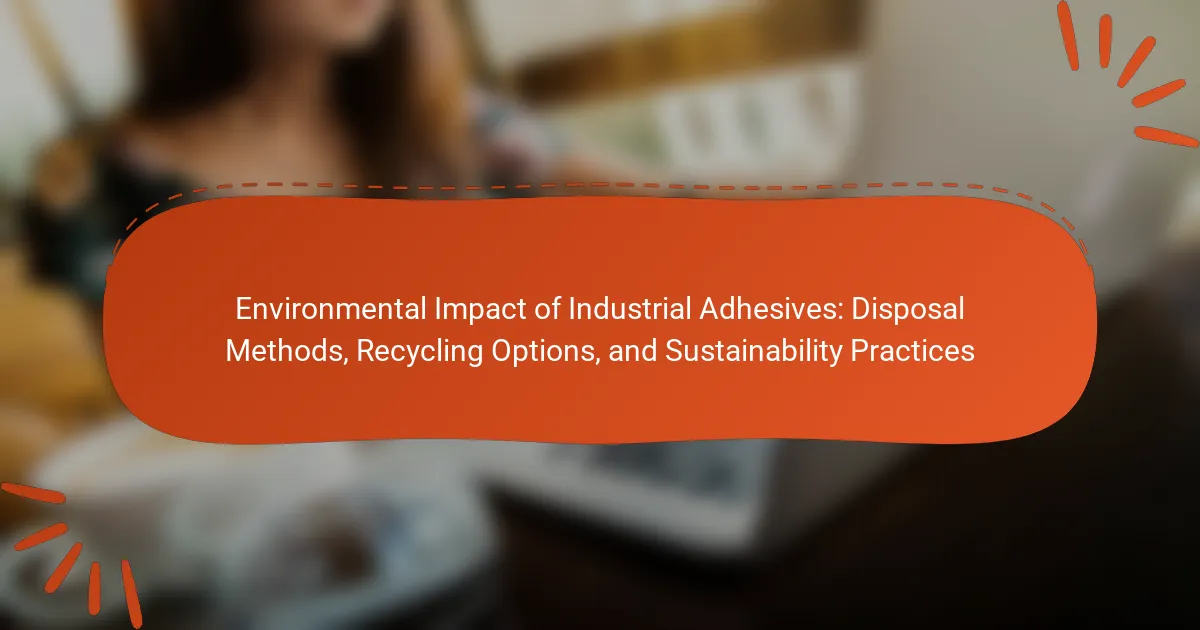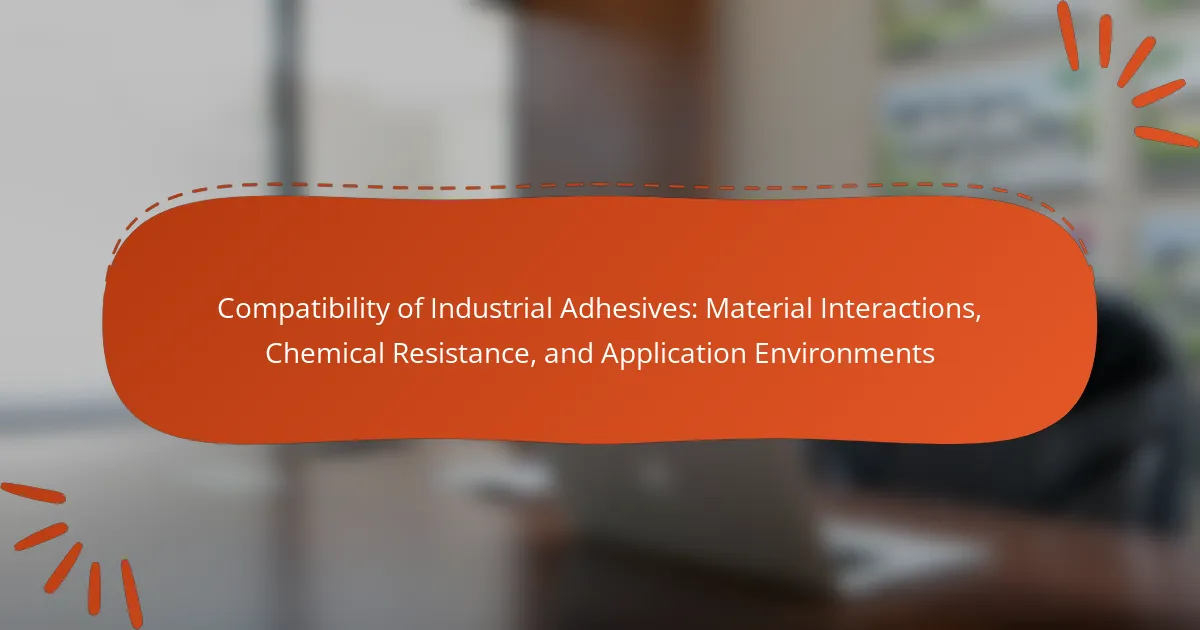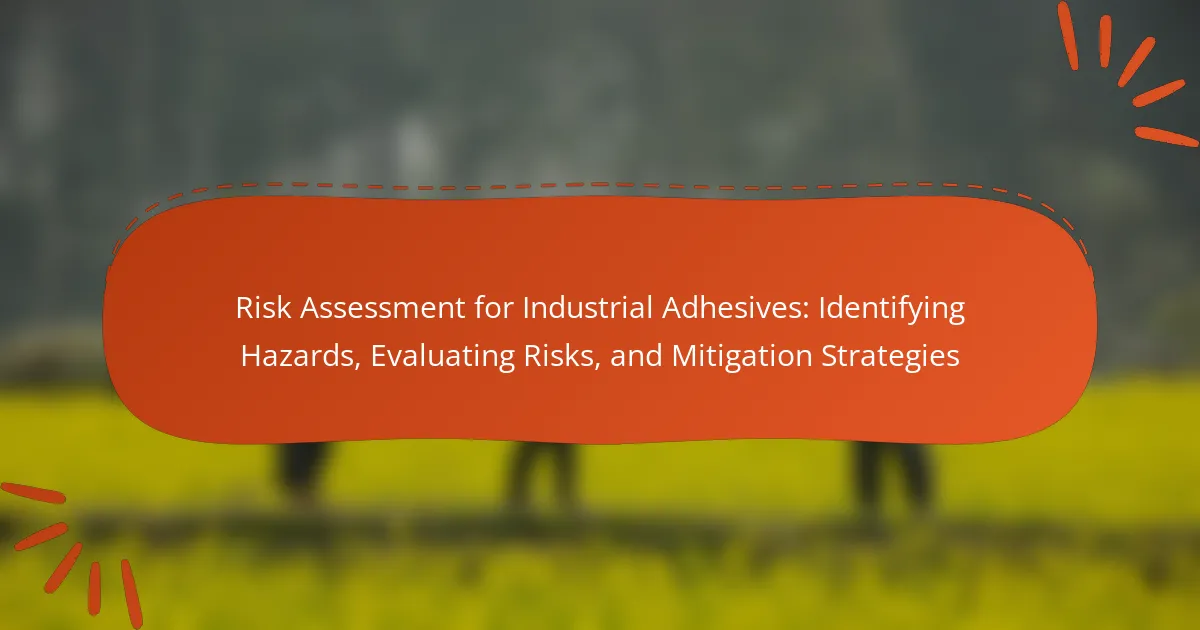Industrial adhesives are essential materials used in various manufacturing processes, but their environmental impact is significant. The production and disposal of these adhesives often involve volatile organic compounds (VOCs) that contribute to air pollution and health issues. Improper disposal methods, such as landfilling, can lead to soil and water contamination, while many adhesives are non-biodegradable, resulting in long-term waste accumulation. This article examines the environmental consequences of industrial adhesives, focusing on disposal methods including incineration, landfill, and recycling options. It also highlights sustainable practices that can mitigate their ecological footprint, emphasizing the importance of adhering to guidelines provided by regulatory bodies like the U.S. Environmental Protection Agency.
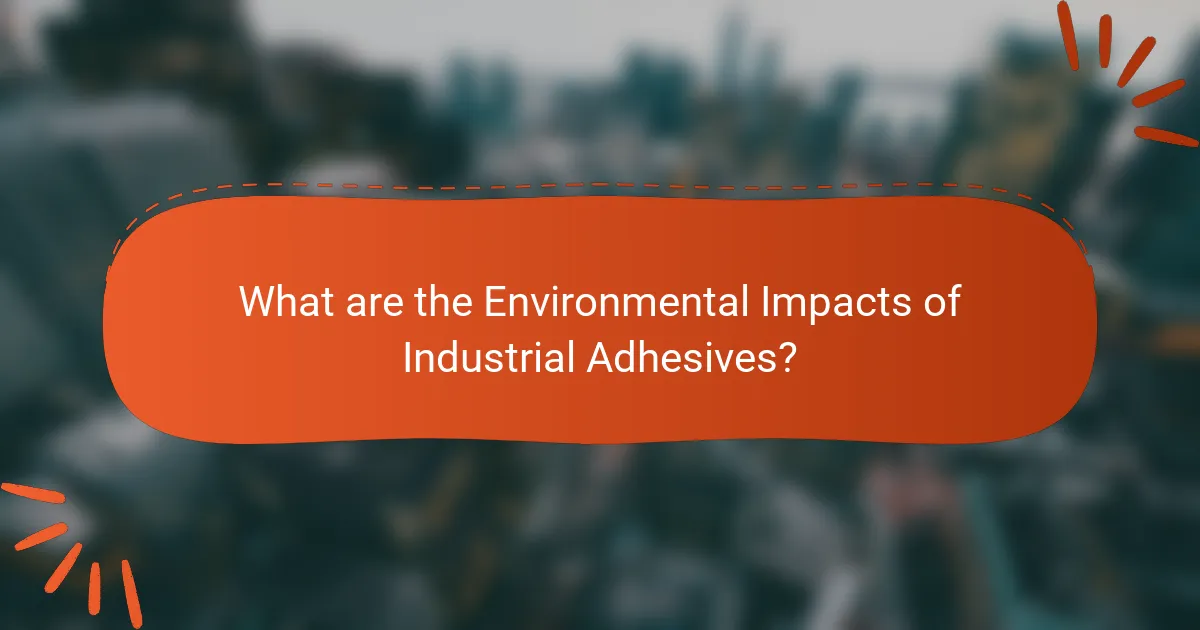
What are the Environmental Impacts of Industrial Adhesives?
Industrial adhesives can significantly impact the environment. Their production often involves volatile organic compounds (VOCs), which contribute to air pollution. VOCs can lead to respiratory problems and environmental degradation. Additionally, improper disposal of adhesives can contaminate soil and water sources. Many adhesives are not biodegradable, leading to long-term waste accumulation. The manufacturing process also consumes energy and resources, contributing to carbon emissions. Furthermore, certain adhesives may contain harmful chemicals that pose risks to ecosystems. These factors highlight the need for sustainable practices in adhesive use and disposal.
How do industrial adhesives affect air quality?
Industrial adhesives can negatively affect air quality. They often contain volatile organic compounds (VOCs). VOCs can evaporate into the air and contribute to air pollution. Exposure to these compounds can lead to health issues for workers and nearby residents. Studies show that certain adhesives release harmful emissions during application and curing. For instance, adhesives used in construction may emit high levels of formaldehyde. This can result in respiratory problems and other health concerns. Proper ventilation and low-VOC options can mitigate these effects. Regulations exist to limit VOC emissions from industrial adhesives.
What volatile organic compounds (VOCs) are released by industrial adhesives?
Industrial adhesives release several volatile organic compounds (VOCs). Common VOCs include toluene, xylene, and formaldehyde. These compounds are often present in solvent-based adhesives. They contribute to air pollution and can have health impacts. Toluene is known for its neurotoxic effects. Xylene can cause respiratory issues and skin irritation. Formaldehyde is a recognized carcinogen. The presence of these VOCs varies by adhesive formulation. Understanding these emissions is crucial for environmental and health considerations.
How can these emissions impact human health and the environment?
Emissions from industrial adhesives can significantly impact human health and the environment. These emissions often contain volatile organic compounds (VOCs). VOCs can lead to respiratory issues, headaches, and long-term health complications. Studies show that prolonged exposure can increase the risk of developing chronic diseases.
In the environment, these emissions contribute to air pollution. Airborne VOCs can react with other pollutants to form ground-level ozone. Ground-level ozone is harmful to both human health and vegetation. It can damage crops and reduce agricultural productivity. Additionally, these emissions can contaminate soil and water sources, disrupting ecosystems.
Research indicates that industrial adhesive emissions play a role in climate change. They can contribute to the greenhouse effect, which leads to global warming. This impacts weather patterns and biodiversity. Overall, the emissions from industrial adhesives pose serious risks to both human health and the environment.
What are the effects of industrial adhesives on water resources?
Industrial adhesives can negatively impact water resources through contamination. When disposed of improperly, these substances can leach harmful chemicals into water bodies. Many industrial adhesives contain volatile organic compounds (VOCs) and other toxic ingredients. These chemicals can disrupt aquatic ecosystems and harm wildlife. Research indicates that adhesives can lead to decreased water quality. In some cases, they may cause long-term alterations to water chemistry. This contamination can affect drinking water supplies and aquatic life. Regulatory guidelines often address the safe disposal of these materials to mitigate risks.
How do adhesives contribute to water pollution?
Adhesives contribute to water pollution primarily through improper disposal. When adhesives are discarded, they can leach harmful chemicals into water sources. Many adhesives contain volatile organic compounds (VOCs) and toxic substances. These compounds can contaminate soil and groundwater. Industrial runoff from manufacturing processes can also introduce adhesives into local water systems. Additionally, adhesives used in construction or packaging may wash away during heavy rains. This runoff can carry pollutants into rivers and oceans. Studies show that VOCs can disrupt aquatic ecosystems. Therefore, the improper management of adhesives poses a significant risk to water quality.
What measures can be taken to mitigate water contamination from adhesives?
Implementing proper disposal methods is essential to mitigate water contamination from adhesives. Industrial adhesives often contain harmful chemicals that can leach into water sources. Using designated waste disposal facilities ensures that these substances are treated safely.
Adopting water-based adhesives can significantly reduce the risk of contamination. These adhesives typically have lower volatile organic compounds (VOCs) and are less toxic. Additionally, conducting regular training for employees on safe handling and disposal practices minimizes accidental releases.
Establishing a recycling program for adhesive containers can prevent waste from entering water systems. Monitoring and maintaining equipment can also reduce leaks and spills. Finally, adhering to environmental regulations ensures compliance and promotes responsible practices in adhesive use.
What is the impact of industrial adhesives on soil health?
Industrial adhesives negatively impact soil health. They can introduce harmful chemicals into the soil. These chemicals may disrupt microbial activity essential for nutrient cycling. Research indicates that certain adhesives contain solvents and heavy metals. These substances can lead to soil contamination. Contaminated soil can affect plant growth and soil fertility. Long-term exposure to industrial adhesives can degrade soil structure. This degradation reduces the soil’s ability to retain water and support ecosystems.
How do adhesives affect soil composition and biodiversity?
Adhesives can negatively affect soil composition and biodiversity. When adhesives are disposed of improperly, they can leach harmful chemicals into the soil. These chemicals may alter soil pH and nutrient availability. Changes in soil chemistry can disrupt microbial communities essential for nutrient cycling. Additionally, toxic substances can harm plant growth and reduce species diversity. Research indicates that certain adhesives contain volatile organic compounds (VOCs) that contribute to soil contamination. Studies show that ecosystems with contaminated soil exhibit reduced biodiversity and impaired ecosystem functions.
What practices can reduce soil contamination from adhesive products?
Implementing proper disposal methods can significantly reduce soil contamination from adhesive products. Using designated disposal facilities ensures that adhesives are treated safely. Recycling adhesive containers minimizes waste and prevents leakage into soil. Choosing water-based adhesives reduces harmful chemical exposure. Regular maintenance of equipment prevents spills during application. Educating workers on safe handling practices minimizes accidental contamination. Monitoring and testing soil in areas near adhesive use can identify contamination early. These practices collectively contribute to a healthier environment and reduced soil pollution.

What are the Disposal Methods for Industrial Adhesives?
Disposal methods for industrial adhesives include incineration, landfill, and recycling. Incineration involves burning adhesives at high temperatures to reduce them to ash and gases. This method effectively eliminates hazardous components. Landfill disposal entails placing adhesives in designated waste sites. This method is less environmentally friendly due to potential leachate. Recycling options exist for certain adhesives, particularly those that can be reprocessed into new products. Proper disposal is crucial to minimize environmental harm and comply with regulations. The U.S. Environmental Protection Agency provides guidelines for hazardous waste disposal, ensuring safe practices.
How should industrial adhesives be disposed of safely?
Industrial adhesives should be disposed of according to local hazardous waste regulations. Many industrial adhesives contain chemicals that can be harmful to the environment. It is essential to identify the specific type of adhesive before disposal. Containers should be tightly sealed to prevent leaks. Transport the adhesive to a designated hazardous waste facility. Always follow the Material Safety Data Sheet (MSDS) guidelines for proper disposal methods. Some adhesives may also be eligible for recycling, depending on their composition. Consulting with local waste management authorities can provide additional guidance. Proper disposal helps minimize environmental impact and ensures safety.
What are the recommended practices for disposing of adhesive waste?
Adhesive waste should be disposed of following specific guidelines to minimize environmental impact. First, check local regulations for disposal requirements. Many areas classify adhesive waste as hazardous waste. Such waste often requires special handling and disposal methods.
For non-hazardous adhesive waste, recycling options may be available. Some facilities can process adhesive materials for reuse. Ensure that adhesive containers are empty before disposal. This reduces contamination and enhances recycling potential.
Always label adhesive waste containers clearly. This practice informs handlers about the contents and required safety measures. When in doubt, consult with waste management professionals for guidance. Following these practices helps protect the environment and complies with legal standards.
What regulations govern the disposal of industrial adhesives?
The disposal of industrial adhesives is governed by several regulations. These include the Resource Conservation and Recovery Act (RCRA) in the United States. RCRA establishes guidelines for hazardous waste management, including disposal procedures for industrial adhesives classified as hazardous.
Additionally, the Clean Water Act (CWA) regulates discharges of pollutants into water bodies. This applies to adhesives that may contaminate water sources during disposal. The Occupational Safety and Health Administration (OSHA) also sets standards for worker safety when handling and disposing of industrial adhesives.
In Europe, the Waste Framework Directive outlines waste management principles, including the disposal of adhesives. Compliance with these regulations is crucial for minimizing environmental impact.
What are the risks associated with improper disposal of adhesives?
Improper disposal of adhesives poses several environmental and health risks. These substances can release toxic chemicals into soil and water. Volatile organic compounds (VOCs) from adhesives can contribute to air pollution. Contaminated water sources can harm aquatic life and disrupt ecosystems. Additionally, improper disposal may lead to hazardous waste accumulation in landfills. This can result in long-term soil contamination. Exposure to these chemicals can also pose health risks to humans, including respiratory issues and skin irritations. Overall, the risks underline the importance of proper adhesive disposal methods.
How can improper disposal impact local ecosystems?
Improper disposal can severely harm local ecosystems. Contaminants from improperly disposed materials can leach into soil and water sources. This contamination can disrupt the natural balance of local flora and fauna. Toxic chemicals can kill aquatic life and reduce biodiversity. Polluted water can affect drinking supplies for both humans and wildlife. Additionally, invasive species may thrive in areas where waste accumulates. These species can outcompete native organisms, further diminishing local ecosystems. Studies show that improper waste management contributes to habitat destruction and long-term ecological damage.
What penalties exist for non-compliance with disposal regulations?
Penalties for non-compliance with disposal regulations can include fines, legal action, and remediation costs. Regulatory agencies may impose fines that range from hundreds to millions of dollars, depending on the severity of the violation. Legal action may result in criminal charges, especially for egregious violations. Companies may also face mandatory clean-up costs for improper disposal. In addition, non-compliance can lead to reputational damage and loss of business licenses. Compliance with disposal regulations is crucial to avoid these penalties and protect the environment.
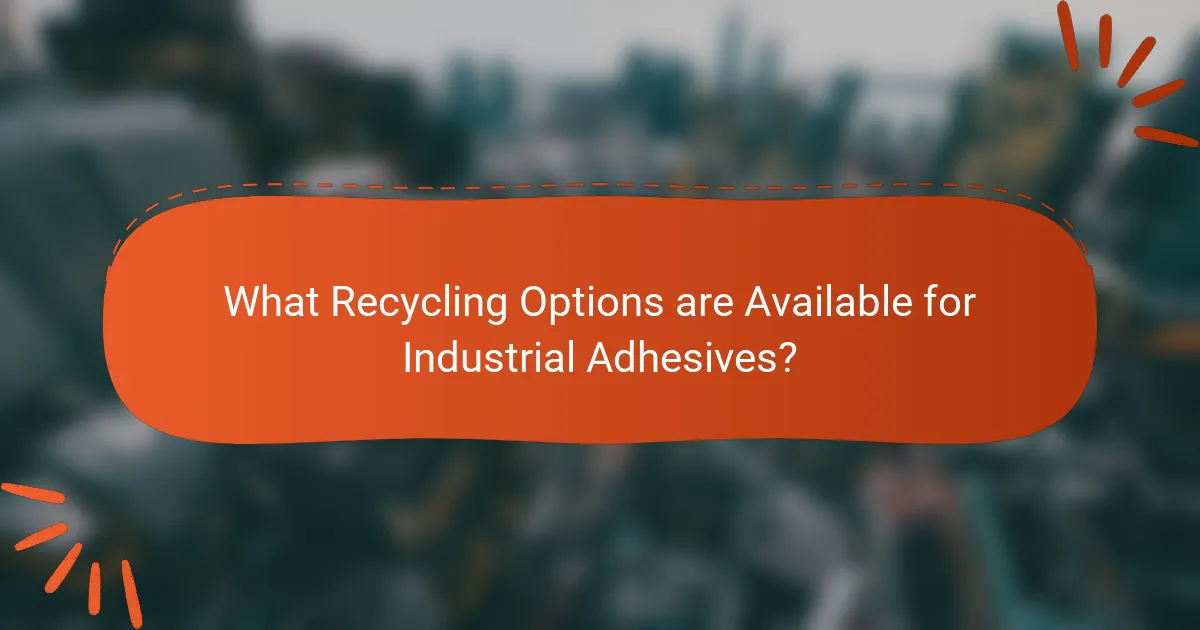
What Recycling Options are Available for Industrial Adhesives?
Recycling options for industrial adhesives include chemical recycling, energy recovery, and material recovery. Chemical recycling involves breaking down adhesives into their original components for reuse. This process can effectively recover valuable raw materials. Energy recovery involves incineration of adhesives to generate energy, which can be used in industrial processes. Material recovery focuses on separating adhesive residues from substrates for recycling purposes. These methods help reduce waste and promote sustainability in adhesive usage. According to the American Chemical Society, recycling industrial adhesives can significantly lower environmental impact.
How can industrial adhesives be recycled effectively?
Industrial adhesives can be recycled effectively through several methods. First, manufacturers can collect used adhesives and separate them from other waste materials. Second, they can utilize chemical recycling processes to break down adhesives into their original components. This allows for the recovery of raw materials for new adhesive production. Third, some companies employ mechanical recycling by grinding adhesive waste into powder, which can be used in new formulations. Additionally, partnerships with specialized recycling facilities can enhance recycling rates. Research indicates that effective recycling can reduce environmental impact by decreasing landfill waste and conserving resources.
What processes are involved in recycling adhesive materials?
Recycling adhesive materials involves several key processes. The first step is the collection of adhesive waste. This waste is then sorted to separate adhesive materials from non-adhesive components. Following sorting, the adhesive materials undergo cleaning to remove contaminants.
Next, the cleaned adhesive materials are processed for size reduction, often through shredding or grinding. After size reduction, the materials may be subjected to chemical treatment to break down the adhesive properties. This allows for easier reprocessing or repurposing.
Finally, the recycled adhesive materials can be blended with new materials or used in the production of new adhesive products. These processes help minimize environmental impact by reducing waste and promoting sustainability in adhesive use.
Which types of adhesives are most suitable for recycling?
Water-based adhesives are most suitable for recycling. These adhesives contain fewer harmful solvents, making them easier to process. They typically break down more easily during recycling. Solvent-based adhesives pose challenges due to their chemical composition. Hot melt adhesives can also be recycled, but their effectiveness depends on the material they are bonded to. Pressure-sensitive adhesives have limited recyclability due to residue left on surfaces. Overall, water-based options are preferred for sustainable recycling practices.
What are the benefits of recycling industrial adhesives?
Recycling industrial adhesives reduces waste and conserves resources. It minimizes the environmental impact of adhesive production. By recycling, manufacturers can reclaim valuable materials, decreasing the need for new raw materials. This process also lowers energy consumption associated with producing new adhesives. Recycling helps in reducing landfill usage, which is crucial for sustainable waste management. Furthermore, it can lead to cost savings for companies by lowering disposal fees. Studies show that recycling programs can improve overall sustainability efforts in manufacturing.
How does recycling contribute to sustainability in manufacturing?
Recycling contributes to sustainability in manufacturing by reducing waste and conserving resources. It minimizes the demand for raw materials. This leads to less energy consumption during material extraction and processing. Recycling also lowers greenhouse gas emissions associated with production. For instance, recycling aluminum saves up to 95% of the energy required to produce new aluminum from bauxite. Additionally, it decreases landfill usage, which mitigates environmental pollution. Overall, recycling fosters a circular economy, promoting resource efficiency and sustainability in manufacturing processes.
What economic advantages does recycling provide for businesses?
Recycling provides significant economic advantages for businesses. It reduces waste disposal costs, leading to lower operational expenses. Businesses can also save on raw material costs by reusing recycled materials. According to the Environmental Protection Agency, recycling can save businesses up to 30% on material costs. Additionally, recycling can enhance a company’s brand reputation, attracting environmentally conscious consumers. This can lead to increased sales and customer loyalty. Furthermore, businesses may qualify for tax incentives and grants for implementing recycling programs. Overall, recycling contributes to both cost savings and potential revenue growth.
What Sustainable Practices Can Be Adopted in Adhesive Use?
Sustainable practices in adhesive use include selecting eco-friendly adhesives, optimizing application methods, and enhancing end-of-life management. Eco-friendly adhesives are made from natural materials and have lower volatile organic compounds (VOCs). Optimizing application methods reduces waste and energy consumption. For instance, using precise dispensing systems minimizes excess adhesive. Additionally, implementing recycling programs allows for the recovery of adhesive materials. Research shows that proper disposal and recycling can significantly reduce environmental impact. According to the Environmental Protection Agency, reducing adhesive waste through recycling can lower landfill contributions by up to 30%.
How can manufacturers reduce the environmental footprint of adhesives?
Manufacturers can reduce the environmental footprint of adhesives by using bio-based materials. These materials are derived from renewable resources, decreasing reliance on fossil fuels. Implementing water-based adhesives can also minimize volatile organic compounds (VOCs) emissions. VOCs contribute to air pollution and health issues. Additionally, optimizing production processes can enhance efficiency and reduce waste. Recycling programs for adhesive containers can further lower environmental impact. Life cycle assessments help manufacturers identify areas for improvement. By adopting these practices, the overall sustainability of adhesive products can be significantly enhanced.
What are the best practices for selecting eco-friendly adhesives?
The best practices for selecting eco-friendly adhesives include evaluating the ingredients, considering certifications, and assessing performance. Choose adhesives with natural or renewable materials. Look for certifications like Green Seal or UL Environment. These indicate compliance with environmental standards. Assess the adhesive’s performance for specific applications. Ensure it meets strength and durability requirements. Review the manufacturer’s transparency regarding the product’s environmental impact. Consider the adhesive’s lifecycle, including disposal and recyclability. Selecting adhesives with low volatile organic compounds (VOCs) reduces indoor air pollution. These practices promote sustainability and minimize environmental harm.
What are the future trends in sustainable adhesive technologies?
Future trends in sustainable adhesive technologies focus on bio-based and recyclable materials. Innovations are leading to adhesives made from natural sources like plant extracts. These bio-based adhesives reduce reliance on petroleum-based products. Additionally, advancements in chemical recycling processes are enhancing the recyclability of traditional adhesives. This allows for the recovery and reuse of adhesive materials after their initial application. Companies are also exploring low-VOC formulations to minimize harmful emissions. Regulatory pressures are driving the adoption of greener alternatives in the industry. Furthermore, the integration of smart technologies is emerging, enabling adhesives that can adapt to environmental changes. These trends reflect a significant shift towards sustainability in adhesive manufacturing and application.
How are innovations in adhesive formulations impacting sustainability?
Innovations in adhesive formulations are significantly enhancing sustainability. New formulations are increasingly bio-based, reducing reliance on petroleum-derived materials. These adhesives often feature lower volatile organic compounds (VOCs), minimizing harmful emissions during application. Advances in recycling technologies allow for easier recovery of adhesives from composite materials. This results in less waste and improved circular economy practices. Additionally, some innovations focus on creating adhesives that are easier to decompose or recycle. Research shows that using water-based adhesives can reduce environmental impact compared to traditional solvent-based options. These advancements collectively contribute to a more sustainable adhesive industry.
What role do consumers play in promoting sustainable adhesive practices?
Consumers play a crucial role in promoting sustainable adhesive practices. Their purchasing decisions influence manufacturers to adopt eco-friendly materials. By choosing products with sustainable adhesives, consumers drive demand for greener options. This demand encourages companies to innovate and improve their adhesive formulations. Additionally, consumers can advocate for transparency in labeling and ingredient sourcing. Educated consumers raise awareness about the environmental impact of adhesives. Their feedback can lead to better practices and policies in the adhesive industry. Overall, consumer behavior directly impacts the sustainability efforts of manufacturers.
The primary entity of the article is industrial adhesives, which are substances used to bond materials in various industries. The article examines the environmental impacts of industrial adhesives, focusing on their contribution to air and water pollution, soil contamination, and health risks associated with volatile organic compounds (VOCs). It also outlines disposal methods, such as incineration and recycling, while emphasizing the importance of sustainable practices and eco-friendly alternatives in adhesive production and use. Key information includes the need for proper disposal to mitigate environmental harm, the benefits of recycling, and future trends in sustainable adhesive technologies.
